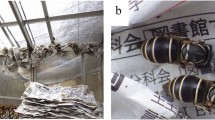Summary:
Laboratory rearing of wasps was studied in the European hornet Vespa crabro. Males (N = 10) and gynes (N = 13) were obtained from two field-caught colonies. Mating took place in cages (mean number of 1.31 ± 0.63 matings per gyne) and overwintering in a cool room at 10 °C. Five gynes survived and one queen successfully established a nest that produced sexuals. This is first time that the entire colony life cycle of V. crabro has occurred in captivity. The technique will be useful in vespine research as well as in conservation and breeding programs.
Similar content being viewed by others
Author information
Authors and Affiliations
Additional information
Received 7 February 2000; revised 30 May 2000; accepted 28 June 2000.
Rights and permissions
About this article
Cite this article
Hoffmann, W., Neumann, P. & Schmolz, E. Technique for rearing the European hornet (Vespa crabro) through an entire colony life cycle in captivity. Insectes soc. 47, 351–353 (2000). https://doi.org/10.1007/PL00001729
Issue Date:
DOI: https://doi.org/10.1007/PL00001729




